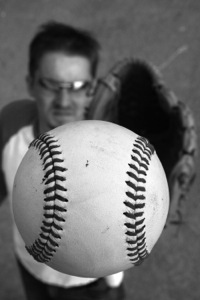
Most Americans think of April 15 as tax day. But for baseball fans, it’s Jackie Robinson Day, a celebration of the man who 65 years ago broke baseball’s color barrier. The players all wear number 42, and stadiums around the country have pre-game events.
The announcers appropriately recapped Robinson’s accomplishments. As an athlete, he was the first UCLA Bruin to letter in four sports, and a NCAA long jump champion. As a player, he remains one of the best second basemen in history, having won the Rookie of the Year Award (at 28), a Most Valuable Player Award, a batting title and the sabermetrics crowd. His “wins above replacement” (WAR) was best in the league twice, in the top 10 six times (according to ESPN). As a man, he underwent a court martial for not accepting segregation while in the military (he was later given an honorable discharge), and gracefully heard all manner of racial slurs for playing the game as well as any white man, and better than most.
Too often, baseball promotes the Jackie Robinson story as a victory of Major League Baseball achieving integration. Fortunately, Sunday night, one of announcers caught himself, suggesting “perhaps we shouldn’t be too proud of just treating people equally.” Perhaps you should not.
Jackie Robinson deserved the adulation he continues to receive, and probably more. But baseball? Not so much. Major League Baseball (MLB) is committed to profit, not equality, and it wanted the African American market. As a monopoly with an anti-trust exemption, there was no real risk that fans would leave in droves over the long term. The risk was to the players, like Jackie Robinson.
MLB’s notable lack of an openly gay player is an even better argument against a commitment to equality. Statistically, and simply realistically, there must be multiple gay baseball players. The roster of players on the DL (Down Low, not Disabled List) may not be known to Commissioner Bud Selig, but it’s hardly unknowable. In many ways, adding a gay player today would be easier than adding Robinson in 1947.
Robinson’s debut, of course, was not an accident. It was a well-orchestrated effort between MLB and the Dodgers, choosing Robinson for what he could do off the field more than on it. If Selig made it clear that it was time for an out baseball player, he wouldn’t even have the problem of choosing from outside the league – he would just have to support a courageous current player.
It’s so intuitive, in fact, that one wonders why it hasn’t happened. With half the country supporting marriage equality, the risk seems small, but MLB whiffs at even small chances to show tolerance. Pitcher Carl Pavano was recently the victim of alleged blackmail by a jilted lover from a gay relationship. In a world of It Gets Better videos, Pavano, or the Twins, or baseball could have signaled that there is nothing wrong with being gay. In a league that can make rules on facial hair and perform random urine tests, exerting that sort of message control would seem easy.
Unfortunately, MLB is still fighting for ratings based on an antiquated notion of machismo and how it sells. Despite the efforts of athlete activists like Hudson Taylor and John Amaechi, owners seem worried that the first sport to have a gay player will lose market share to the others. So perhaps it’s time for another approach. Imagine the difference if there were an LGBT owner, who could make it clear that his or her team wanted diversity.
Imagine the coverage if MLB tried to keep them out. The Padres are for sale. Now all we need is a billionaire. Paging Bruce Bastian.










